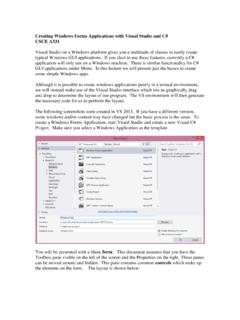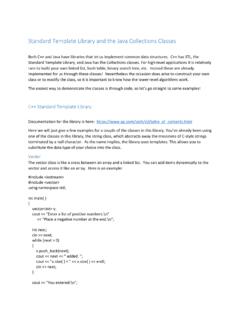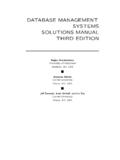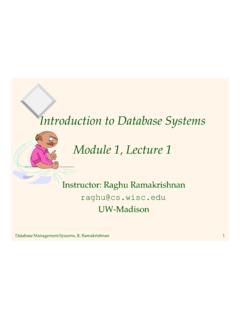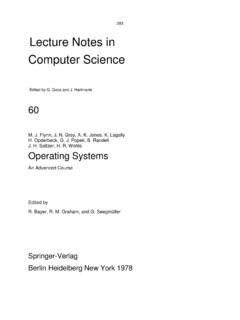Transcription of Introduction to Database Systems - math.uaa.alaska.edu
1 10/19/20091 Introduction to Database SystemsIntroduction to Database Systems So, what is a Database , anyway? An integrated, self-describing collection of data about related sets of things and the relationships among them10/19/20092If you burned down all our plants, and we just kept our people and our information files, we should soon be as strong as Watson, Jr. Former chairman of IBMD atabase Management Systems Simple text files or office documents are one way to store data: Fine for small amounts of data But impractical for large amounts of data Businesses must maintain huge amounts of data A Database management system (DBMS) is the typical solution to the data needs of business Designed to store, retrieve, & manipulate data Most programming languages can communicate with several DBMS Tells DBMS what data to retrieve or manipulate10/19/20093 File vs.
2 Database organizationLayered Approach to Using a DBMS Applications that work with a DBMS use a layered approach Application is topmost layer Application sends instructions to next layer, the DBMS DBMS works directly with data Programmer need not understand the physical structure of the data Just need to know how to interact with the database10/19/20094 Why not just use the file system ? ,drive to work9,teach class10, ,drive to work9,eat donut10, Could write programs to operate on this text file Storage Problems Sharing data Same data may be duplicated many times Need to write custom programs to manipulate the data ( search, print) As file Systems become more complex, managing files gets more difficult Making changes in existing file structures is important and difficult.
3 Security, data integrity (redundancy, inconsistency, anomalies) features are difficult to implement and are Storage Problems - Dependence Structural Dependence: A change in the file s structure requires the modification of all programs using that file. Data Dependence: A change in any file s data characteristics requires changes of all data access programs. Solution: DBMS Logically related data are stored in a single data repository. The Database represents a change in the way end user data are stored, accessed, and managed efficiently. Easier to eliminate most of the file system s data inconsistency, data anomalies, and data structural dependency problems. Store data structures and relationships (schema) DBMS takes care of defining all the required access of DBMS Cost of software and implementation Higher cost of processing routine batches Increase magnitude of potential disaster Lack of Database technical capabilityRelational Database Model Introduced in the 60 s and 70 s and is the most common type of DBMS today Data elements stored in simple tables (related) General structure good for many problems Easy to understand, modify, maintainExamples.
4 MySQL, Access, Oracle, SQL Server We will focus on relational databases using Microsoft Access in our course10/19/20097 The Relational Model Views entities as two-dimensional tables Records are rows Attributes (fields) are columns Tables can be linked Supports one-to-many, many-to-many, and one-to-one relationshipsTerminology Database : a collection of interrelated tables Table: a logical grouping of related data A category of people, places, or things For example, employees or departments Organized into rows and columns Field: an individual piece of data pertaining to an item, an employee name for instance Record: the complete data about a single item such as all information about an employee A record is a row of a table10/19/20098 Emp_Id First_Name Last_Name Department001234 IgnacioFletaAccounting002000 ChristianMartinComputer Support002122 OrvilleGibsonHuman Resources003400 BenSmithAccounting003780 AllisonChongComputer SupportDatabase TableRow(Record)
5 ColumnField Each table has a primary key Uniquely identifies that row of the table Emp_Id is the primary key in this example Serves as an index to quickly retrieve the record Columns are also called fieldsor attributes Each column has a particular data typeChoosing Column Names Define a column for each piece of data Allow plenty of space for text fields Avoid using spaces in column names For the members of an organization:Column NameTypeRemarksMember_IDintPrimary keyFirst_Namevarchar(40)Last_Namevarchar (40) Phonevarchar(30) Emailvarchar(50) Date_JoinedsmalldatetimeDate only, no time valuesMeeings_AttendedsmallintOfficerYes /NoTrue/False values10/19/20099 Database design minimizes redundant data In the following employee table.
6 IDFirst_NameLast_NameDepartment001234 IgnacioFletaAccounting002000 ChristianMartinComputer Support002122 OrvilleGibsonHuman Resources00300 JoseRamirezResearch & Devel003400 BenSmithAccounting003780 AllisonChongComputer Support Same dept name appears multiple times Requires additional storage space Causes problems if misspelled What if a department needs to be renamed?Issues with Redundant Data Create a department tableDept_IDDept_NameNum_Employees1 Human Resources102 Accounting53 Computer Support304 Research & Development15 Reference department table in employee tableIDFirst_NameLast_NameDept_ID001234 IgnacioFleta2002000 ChristianMartin3002122 OrvilleGibson1003000 JoseRamirez4003400 BenSmith2003780 AllisonChong3 Eliminating Redundant Data10/19/200910 The previous changes created a one-to-many relationship Every employee has one and only one dept Every department has many employees DeptID in department table is a primary key DeptID in employee table is a foreign key One-to-many relationship exists when primary key of one
7 Table is specified as a field of another tableOne-to-Many RelationshipsNormalization The previous example illustrated a technique used to make complex databases more efficient called Normalization Break one large table into several smaller tables Eliminates all repeating groups in records Eliminates redundant data Another DataStudentID#StudentNameCampusAddressMa jor Phone CourseIDCourseTitleInstructorNameA121 Joy Egbert 100 N. State Street MIS 555-7771 MIS 350 Intro. MISVan DeventerA121 Joy Egbert 100 N. State Street MIS 555-7771 MIS 372 DatabaseHannA121 Joy Egbert 100 N. State Street MIS 555-7771 MIS 375 Elec. Comm. ChatterjeeA121 Joy Egbert 100 N.
8 State Street MIS 555-7771 MIS 448 Strategic MIS ChatterjeeA121 Joy Egbert 100 N. State Street MIS 555-7771 MIS 474 Telecomm GilsonA123 Larry Mueller 123 S. State Street MIS 555-1235 MIS 350 Intro. MISVan DeventerA123 Larry Mueller 123 S. State Street MIS 555-1235 MIS 372 DatabaseHannA123 Larry Mueller 123 S. State Street MIS 555-1235 MIS 375 Elec. Comm. ChatterjeeA123 Larry Mueller 123 S. State Street MIS 555-1235 MIS 448 Strategic MIS ChatterjeeA124 Mike Guon 125 S. ElmMGT 555-2214 MIS 350 Intro. MISVan DeventerA124 Mike Guon 125 S. ElmMGT 555-2214 MIS 372 DatabaseHannInstructorLocationT240CT240F T240DT240DT240ET240CT240FT240DT240DT240C T240 FInstructorPhone555-2222555-2224555-2228 555-2228555-2226555-2222555-2224555-2228 555-2228555-2222555-2224 TermF'98F'98F'98F'98F'98F'98F'98F'98F'98 F'98F'98 GradeABB++++A C++++AB A C++++A A A124 Mike Guon 125 S.
9 ElmMGT 555-2214 MIS 375 Elec. Comm. ChatterjeeA124 Mike Guon 125 S. ElmMGT 555-2214 MIS 474 Telecomm GilsonA126 Jackie Judson 224 S. Sixth Street MKT 555-1245 MIS 350 Intro. MIS Van DeventerA126 Jackie Judson 224 S. Sixth Street MKT 555-1245 MIS 372 DatabaseHannA126 Jackie Judson 224 S. Sixth Street MKT 555-1245 MIS 375 Elec. Comm. ChatterjeeA126 Jackie Judson 224 S. Sixth Street MKT 555-1245 MIS 474 Telecomm '98F'98F'98F'98F'98F' ++++BAB++++B++++A ..Enrolled TableStudentID#A121A121A121A121A121A123A 123A123A123A124A124 CourseIDMIS 350 MIS 372 MIS 375 MIS 448 MIS 474 MIS 350 MIS 372 MIS 375 MIS 448 MIS 350 MIS 372 GradeABB++++A C++++AB A C++++A A TermF'98F'98F'98F'98F'98F'98F'98F'98F'98 F'98F'98A124A124A126A126A126A126 MIS 375 MIS 474 MIS 350 MIS 372 MIS 375 MIS 474B++++BAB++++B++++A F'98F'98F'98F'98F'98F' TableInstructorNameVan DeventerHannValacichChatterjeeGilsonInst ructorLocationT240CT240FT240DT240DT240 EInstructorPhone555-2222555-2224555-2223 555-2228555-2226 Teaching AssignmentCourseIDMIS 350 MIS 372 MIS 375 MIS 448 MIS 474 InstructorNameVan
10 DeventerHannChatterjeeChatterjeeGilsonTe rmF'98F'98F'98F'98F' TableCourseIDCourseTitleMIS 350 Intro. MISMIS 372 DatabaseMIS 375 Elec. 448 Strategic MISMIS 474 DataStudentID#Student TableStudentNameCampusAddressMajor PhoneA121 Joy Egbert 100 N. State Street MIS 555-7771A123 Larry Mueller 123 S. State Street MIS 555-1235A124 Mike Guon 125 S. ElmMGT 555-2214A126 Jackie Judson 224 S. Sixth Street MKT Your company uses the following spreadsheet. How might it be normalized into Database tables?Associations Relationships among the entities in the data structures Three types One-to-one One-to-many Many-to-many Relationships set by placing primary key from one table as foreign key in another Creates acceptable redundancy10/19/200913 Association ExamplesEMPLOYEESPOUSEEMPLOYEESPOUSEFACU LTYADVISEEFACULTYCOURSEOne-to-one (1:1)One-to-many (1:M)Many-to-many ( :M)AssociationsOrder (Order #,Order_Date, Customer)Product(Prod #,Prod_Description, Qty)Product_Order(Order #, Prod #,Order #, Prod #,Customer)Foreign key1MM110/19/200914 Microsoft Access is Unique Provides DBMS functions Not industrial-strength , designed for.

